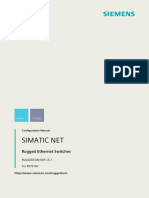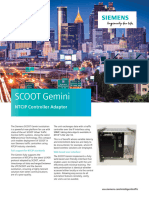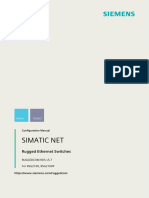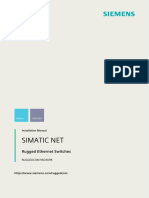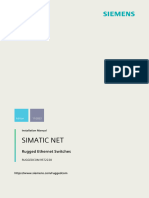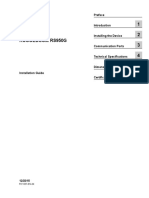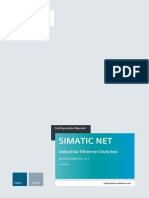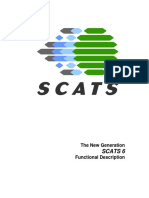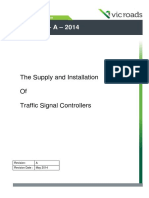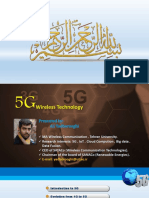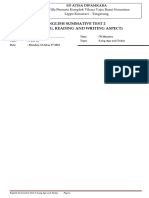RMS
Remote Monitoring System
Traffic Solutions
� Faults are time-stamped and logged on receipt at the instation
Remote Monitoring System and innovative tabbed displays allow easy filtering of
information to be viewed. Where hard copy records of fault
The Siemens Remote Monitoring and Control System (RMS) receipts are required, fault information may be automatically
is an easy to use and highly reliable facility, enabling the directed to up to two local or networked ‘logging’ printers.
efficient monitoring and management of a wide range of
on-street equipment. The system features an advanced Integration with other systems
instation, which allows operators to appreciate the status
Siemens RMS instation may be installed on the same machine
of all monitored equipment at a glance, using a fully user
as a Siemens Prefect fault management system, allowing faults
customisable map-based display.
to be passed automatically from RMS to Prefect and then
Equipment monitoring is performed by Siemens Gemini directly on to the maintenance organisation for action, without
outstation which is easily installed in most equipment operator intervention. This close integration allows both
housings. Fault and status reporting is via a PSTN or GSM applications to share the same communication modems and
network, allowing the most cost-effective communications telephone lines, reducing infrastructure costs. Where a single
infrastructure to be chosen on a site-by-site basis. machine is not desirable, integration is still possible via a
network or simple serial interconnection. To enhance further
the task of managing on-street equipment, data such as
RMS provides the optimum solution for monitoring
pictures, textual notes and log information uploaded from
applications. The system also offers the option of a fully
traffic controllers may be attached to the site symbol on the
featured, entry level Urban Traffic Control system, employing
map. Data is accessed by simply selecting the site symbol and
dial-up links for the most efficient coordination of traffic
picking the information to be displayed from a list of available
signals. RMS may also be used for the remote control of items. The appropriate application for viewing the information
various equipment including variable message signs. is started automatically.
Direct interface to the Siemens Sietag reader also provides
an integrated bus and emergency vehicle priority system, Siemens RMS offers direct connections to other UTMC systems
complete with detailed recording of travel times and events. providing information on the current status and operation of
equipment connected to RMS. This allows the complete
Operator interface network situation to be monitored on a UTMC common
Equipment is identified by symbols positioned on the map database such as Siemens Comet system, as well as the
identifying their location and these are dynamically colour implementation of DUSC control in response to an incident
coded to reflect the fault status of the site. Greater detail or congestion.
sub-maps may be defined and simply accessed to improve
the clarity of the display where overcrowding of Gemini Bus priority and access control
outstation symbols occurs. To further improve operator Up to eight Sietag readers may be connected to the Gemini
recognition of reported faults, an audible and visual alarm may Outstation Monitoring Unit (OMU) using a specially designed
be enabled which can be configured to remain on top of all interface card to provide a sophisticated local bus priority and
running applications until the receipt of the fault information access control system. Vehicles equipped with tags are
has been acknowledged. recognised and logged at the Gemini.
�■ Easy to use and sophisticated
operator interface
■ Seamless integration with other systems
■ Effective bus priority and access control
■ Integrated access to Siemens
MOVA equipment
■ Customisable to match system features
to operational needs
■ Easy to install with comprehensive
customer support
■ Proven and highly reliable outstation units
White and blacklists can be configured at the instation and Strategic control with DUSC
downloaded to the Gemini to provide access control based on Strategic control is implemented using a cableless linking
vehicle identity, operator identity, time and date. Ranges can (CLF) principle, but with plans being prepared and downloaded
be specified so that large numbers of vehicles can be granted from the instation and implemented in each outstation. Plan
access with minimum configuration effort. The above features modification is simple and quick, because there is no need to
also allow the Gemini to recognise priority vehicles and pass hold the plans in the traffic controller configuration. Up to
priority requests to traffic control equipment, providing a very 16 plans, each with as many as 32 groups, complete with
cost-effective bus priority and access control system. complex demand dependent conditioning, may be configured.
Unlike some CLF implementations, DUSC allows complex
Siemens MOVA equipment conditions such as demand dependency to influence plan
Siemens Gemini MOVA units may be integrated with the operation, enabling traffic flows to be maximised without
instation map display so that access to them is simply disrupting intended green progressions. An advanced master
achieved by clicking on their map symbol. To simplify user time clock facility allows plans to be introduced by time and
activities, the instation manages communication with the day of the week, or for public holidays and special occasions.
MOVA unit and launches the appropriate TRL applications Importantly, time synchronisation of the whole system is
as required. maintained from the instation by regular automatic status
calls to each Gemini OMU. The frequency of these may be
Matching system features to operational needs programmed by the operator but is typically set at once a day.
In a multi-staff environment, ensuring correct levels of access
and clear indication of functionality available to different Outstation units
operators are important considerations. With Siemens RMS, The Gemini OMU has been proven to be highly reliable in
this is facilitated by the provision of five user-configurable several thousand installations and its small 3U size enables
log-on levels. A system administrator may set the facilities it to be easily mounted in a wide variety of traffic controllers
available at each level and the menu descriptions for each and other equipment.
facility. Access to each level is enabled by a password defined
by the system manager thus preventing access to the system The Gemini is able to monitor and report:
by unauthorised personnel.
• Signal lamp failures and replacements
Installation and customer support • Detector and push-button failures
Continuing with the theme of ease of use, the instation • Detector counts (using N and N+1 algorithms)
software is supplied complete with an automated installation • Violations of traffic controller timings
program. Existing database and outstation configuration files
• Traffic controller status via handset terminal port
are automatically updated, maintaining 100% upwards
compatibility with previous versions of Siemens Remote • Status of contact data (from barrier controllers, over height
Monitoring systems. A dedicated Siemens software support detectors, variable message signs or other equipment)
team is also available to provide users with telephone and • Vehicle detections from Sietag readers (and provide priority
e-mail support. based on these detections to an associated traffic controller)
�Configuration
Configuration at the instation is
accomplished using a simple forms-based
editor. Data may be downloaded
remotely via the telephone link, or
locally on site if required. To ensure
maximum utility of fault data generated
by the Gemini, considerable flexibility is
offered in defining limits and sensitivity
for fault conditions as part of the
configuration process. Once configured,
the unit continuously monitors the
operation of its associated equipment.
When it detects a fault, it initiates an
auto-dial sequence establishing a
communication path to the instation
over the telephone network. To minimise
call costs, configuration options allow
faults to be classified. Those faults that
are non-urgent are recorded at the
Gemini outstation but not uploaded
unless requested by an operator at the
instation, or an urgent fault is detected.
For further information, please contact: © Siemens plc 2007. All rights reserved.
Siemens Mobility, Traffic Solutions, Sopers Lane, Poole,
This publication is issued to provide outline information only,
Dorset BH17 7ER UK
which (unless agreed by the Company in writing) may not be
Telephone: +44 (0) 1202 782000 used, applied or reproduced for any purpose or form part of
any order or contract or be regarded as a representation
E-mail: sales.stc@siemens.com relating to the products or service concerned. The Company
reserves the right to alter without notice this specification,
www.siemens.co.uk/traffic design, price or conditions of supply of any product or service.
STC-BR20-05

